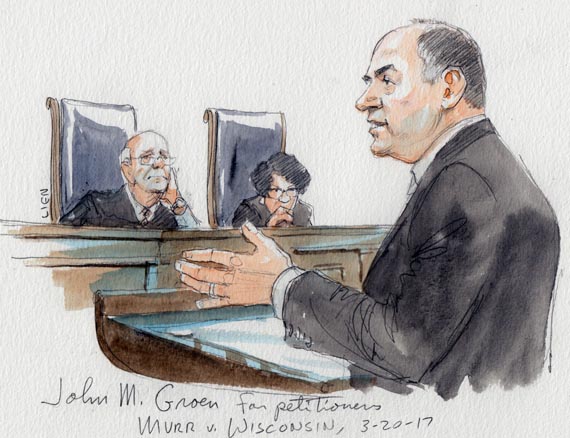Argument analysis: Justices search for a common denominator in takings case

on Mar 21, 2017 at 1:55 pm
At yesterday’s oral argument in Murr v. Wisconsin, the justices discussed a longstanding dilemma in the field of regulatory takings. As I described in my earlier post, the Fifth Amendment’s prohibition on uncompensated government takings of private property includes instances when, in Justice Holmes’ famously vague formulation, a regulation “goes too far.” But to assess a regulation’s impact on a property, a court must first answer the threshold question of what property is at issue. The Supreme Court has said the property at issue must be the “parcel as a whole,” but the lower courts have struggled to determine what that means. This is what courts and scholars have termed the “denominator problem.” (For those who are not takings clause devotees, similar comparative issues—think of them as framing problems—arise all the time. My March Madness bracket looks great if you count only first-round games, but not so great once you add in second-round games.)
The facts in this case illustrate the dilemma. In the 1990s, the Murr siblings received two adjacent parcels of waterfront property from their parents. One, Lot E, had been formally owned by their parents; the other, Lot F, by their parents’ plumbing company. Under zoning requirements that took effect in 1976, the lots were “substandard,” meaning they were too small to be built upon individually. The zoning law contained a grandfather clause allowing the lots to be developed separately as long as they were held by different owners. But it also contained a so-called “merger” provision, which excluded commonly owned adjacent lots from the grandfather clause. (Amicus briefs explain that this combination of lot-size requirements, grandfather clauses and merger provisions is common around the country.) The merger provision kicked in when the siblings became the owners of both lots, thus precluding them from selling Lot E by itself, as they had hoped to do. This is where the denominator problem emerges. If the parcel at issue is just Lot E, the Murrs have a stronger case that the merger provision effected a taking: They can’t develop or sell Lot E by itself. But if Lots E and F together constitute the denominator, it seems clear that no taking has occurred. The siblings can still develop or sell the two lots together, and the restriction has a minimal economic effect on them.
So which is it? The four attorneys who argued the case offered four different approaches to the denominator problem. Although phrased in starkly divergent terms, the arguments did eventually reveal some common ground—even beyond the advocates’ “agreement” that, as Wisconsin’s solicitor general put it, this “area of law is incredibly complicated.”
The first attorney to the lectern was John Groen of the Pacific Legal Foundation, representing the Murr siblings. In arguing that the parcel at issue is Lot E, he urged the court to adopt a presumption that the lot lines of the parcel alleged to be taken define the denominator. Lot lines, Groen stated at one point, inform how “people traditionally understand and use [property] in their daily lives” — a point Chief Justice Roberts seemed to accept. Justice Elena Kagan asked why the court shouldn’t look at all of state law, not just lot lines, in defining the denominator. Why exclude the merger provision? “If we’re looking to State law,” she suggested, “let’s look to State law, the whole ball of wax.” In a similar vein, Justice Stephen Breyer asked, why aren’t lot lines just one factor among many? Breyer was skeptical of applying a “mechanical test.”

John M. Groen for petitioners (Art Lien)
Notably, the questioning also drew out that Groen’s lot-line presumption is rebuttable. In response to questions from Justices Anthony Kennedy and Sonia Sotomayor, Groen explained that the presumption could be overcome with evidence of “unity of use”—that is, evidence that the parties were in fact treating the two lots as “an integrated economic unit,” or that other facts “show in fairness and justice that the individual should bear the burden.” This begins to sound a bit like the other side’s test. Indeed, Kennedy asked twice why the “unity of use” notion didn’t defeat the Murrs’ case here. After all, the family did use the parcels together to some extent; according to the briefing, Lot E contained a volleyball court and propane tank that were used in conjunction with Lot F’s cabin.
Misha Tseytlin, the solicitor general of Wisconsin, was next to the podium. He urged the court to adopt a test involving “one straightforward question: Is the land lot at issue completely separate from any other land under State law?” Here, because of the merger provision, he explained, the lots “have merged for all relevant purposes.” This position, too, drew skepticism, this time from Roberts and Kennedy. Kennedy stated, “[i]t seems to me that your position is as wooden and as vulnerable [to] criticism” as the Murrs’. Why elevate the merger provision over lot lines?
Justice Samuel Alito raised a different concern, one based on the court’s existing doctrines: He suggested that the state’s position — that the denominator must be the two parcels together because the siblings took title subject to the pre-existing merger rule — is “completely contrary to the reasoning in” Palazzolo v. Rhode Island. (Palazzolo indicated that a person can assert a regulatory taking even if the person took title to property knowing that the regulation was already on the books.) Tseytlin, echoing an interpretation offered earlier by Kagan, responded that Palazzolo applies only when an earlier and later owner would have the same takings claim. Here, the siblings, as common owners of both lots, have a different claim from their predecessor owners.
Justice Kagan described herself as “pretty sympathetic to the idea that pre-existing state law really does influence quite a bit your expectations about” property, but asked why the state needed a bright-line rule based only on state law. “[W]hat’s the harm,” she asked, in allowing a more “fluid” analysis, in which factors other than state law might sometimes matter? Tseytlin explained the state’s view that the denominator inquiry should be a simple, “straightforward” first step of the analysis. After identifying the parcel, the court should move on to the multi-factor analysis of whether a taking has occurred, following the test set out in a famous case called Penn Central. But to apply a multi-factor test at both steps, Tseytlin said, would amount to “Penn Central squared,” and would lead to an overly complex analysis.
Richard Lazarus of Harvard Law School argued next, on behalf of St. Croix County. Unlike the state, the county embraces a multi-factor test for the denominator. It looks at “three things”: the economic impact of the parcel (the court must “[d]efine the parcel in a way which actually evaluates the real impact”), people’s reasonable expectations based on state law, and “the physical and geographic characteristics of the parcel.” Those three considerations, Lazarus explained, will help guide the court in determining the right parcel — with the point being “to see what the real burden is that people are suffering in the case.” Roberts echoed Tseytlin’s concern about turning the analysis into “Penn Central squared,” and also echoed Groen’s point that lot lines are “the regular way” to “figure out … what the land interest is.” But Lazarus emphasized that, while “[t]here’s no question state law defines what you own,” the takings question — whether, for purposes of federal constitutional law, the economic impact on a property-owner is excessive — is different. Lazarus further noted that several earlier Supreme Court cases evaluated property interests together even though they were defined separately under state law. In response to a question from Breyer, Lazarus added that “this is really the easy case,” because the Murrs face little hardship — indeed, he pointed out, that is the rationale behind the merger provision. A single owner facing development restrictions on a substandard lot might face “a complete economic wipeout,” but the owners of two such lots, “like the Murrs, have development options.”
The final attorney to argue was Elizabeth Prelogar, an assistant to the U.S. solicitor general, appearing as an amicus in support of the state and county. She began by urging the court not to adopt “a presumption or bright line rule that focuses on lot lines in isolation,” arguing that such an approach would have both legal and practical problems. As a practical matter, “lot lines will frequently not be an accurate indicator” of how a person is affected by a regulation, and would exclude “relevant considerations about the on-the-ground economic realities.” In response to a question from Alito, Prelogar stated that her office is asking the court to look for “what in the interest of fairness and justice is an accurate way to measure economic impact.” And in this case, several factors — including the timing of the relevant transfers, the contiguous nature of the parcels and the “linked uses” of the property — show that “it’s proper to view these two parcels together as one integrated whole.”
Sometimes commentators doubt that oral arguments matter much. But this one seemed useful to the justices, as it helped them understand the metes and bounds (sorry) of the parties’ positions. In particular, the argument suggested that the parties may have some common ground. To be sure, each party emphasizes a different part of the denominator inquiry — the Murrs focus on lot lines, the state focuses on the merger provision, and the county and solicitor general stress the need not to apply any one factor too mechanically. But the argument underscored that the Murrs agree that fairness and factual inquiries, and not just lot lines, bear on the analysis. This seemed to pique the interest of Kennedy, likely the swing vote, who seemed resistant to a test that would focus so tightly on one feature of state law that it could miss the forest for the trees. Given that, it’s not hard to imagine a narrow win for the state and county that allows consideration of multiple factors. Such an opinion might speak of the need to look closely at both lot lines and other state law requirements, while eschewing a “wooden” or “mechanical” inquiry that ignores the traditional takings clause emphasis on fairness. Or the court could give the Murrs a narrow win, reversing the decision below and sending the case back to the Wisconsin courts to consider factors left out of their prior analysis. Either way, the case is poised to shed important light on a longstanding dilemma—but probably will not mark the end of debates about the takings denominator.


